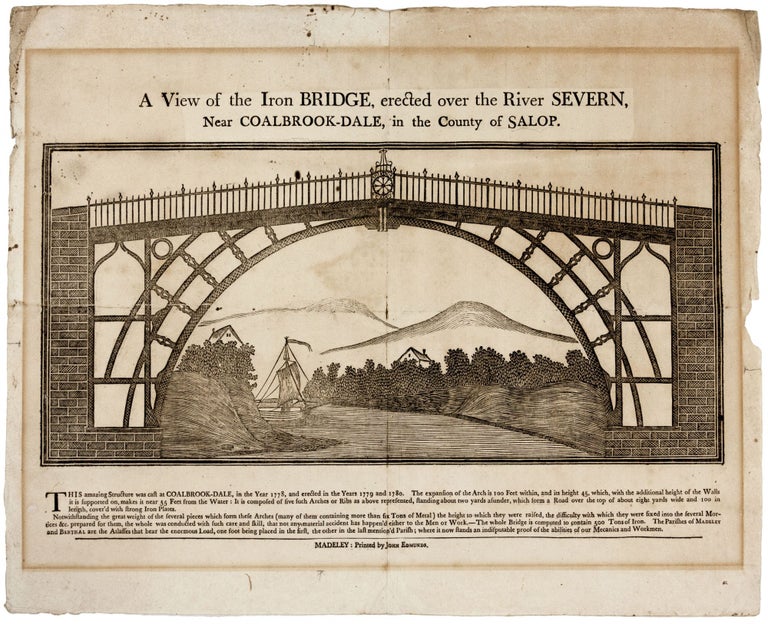
A View of the Iron Bridge, erected over the River Severn, Near Coalbrook-Dale, in the County of Salop.
Folio broadside [48.8 x 39.3 cm], (1) leaf with woodcut image and letterpress text. With slight creasing where folded, toned from matting and minor discoloration, minor edge wear and staining, contemporary pencil calculations on verso, paper support on verso beneath letterpress title. Overall very good and genuine. Rare first edition of one of the first (if not the first) published views of the epoch-making iron bridge over the River Severn at Coalbrookdale in Shropshire, the first major bridge in the world to be made of cast iron, a harbinger of modern architecture, and a monument from the moment of its construction considered to be “one of the most potent symbols of the Industrial Revolution” (Briggs, p. 7). The broadside consists of a large woodcut of the bridge shown in elevation – the River Severn and the surrounding landscape visible under the bridge’s span – and letterpress text lauding the workmanship of the structure, which was cast in 1778 and erected in 1779 and 1780. This sheet was printed just a short walk from the bridge itself, at the shop of John Edmunds in the village of Madeley, and would have been sold as an ephemeral souvenir for all those who came to marvel at the structure. “Advances in engineering and the development of new industrial materials during the 18th century had a profound impact on the history of architecture, leading eventually to the steel-and-glass skyscrapers of cities all over the world today. The first use of iron in bridge design was the cast-iron bridge over the Severn River, near Coalbrookdale in England, where Abraham Darby III (1750-1789), one of the bridge’s two designers, ran his family’s cast-iron business. The Darby family had spearheaded the evolution of the iron industry in England, and they vigorously supported the investigation of new uses for the material. The fabrication of cast-iron rails and bridge elements inspired Darby to work with the architect Thomas F. Prichard (1723-1777) in designing the Coalbrookdale Bridge. The cast-iron armature that supports the roadbed springs from stone pier to stone pier until it leaps the final 100 feet across the Severn river gorge. The style of the graceful center arc echoes the grand Roman aqueducts. At the same time, the exposed structure of the bridge’s cast-iron parts prefigured the skeletal use of iron and steel in the 19th century. Visible structural armatures became expressive factors in the design of buildings such as the Crystal Palace in England and the Eiffel Tower in France” (Kleiner, p. 591). By the 1750s at Coalbrookdale six or more ferry crossings operated in as many miles. They were essential for transporting raw materials across the river to the ironworks and other industries in the valley. The only other crossing was the medieval Buildwas Bridge, two miles upstream. The river was often too shallow in summer and in winter was too swift and high, and so industry was often at the mercy of the seasons. The proposal for a new bridge was inevitable. The building of the bridge was partly a public relations exercise, advertising the versatility of cast iron and the skills of Abraham Darby III and his Coalbrookdale Company, and the site chosen was the most dramatic part of the Gorge. The new bridge was promoted by the 18th century equivalent of a media campaign, with Darby commissioning paintings to advertise the project. This undated broadside, which is sometimes erroneously cataloged as having been produced ‘c. 1790?’, apparently was printed within a year or so of the bridge’s construction and perhaps even as part of Darby’s ongoing promotion of the structure: The bridge is seen here as initially constructed, with its topmost rib/arch stopping short of the abutments at each side, but these ribs were almost immediately lengthened and carried down to the abutment, and they appear in their final form by the time Michel Angelo Rooker (1743-1801) painted his well-known view of the bridge, an engraving of which was published in 1782. Perhaps the present broadside was printed to coincide with the opening of the bridge to traffic in 1781. The broadside is recoded in two issues (priority not known), which differ only very slightly in terms of the setting of the type and the form of the printer’s name (“John Edmunds” versus “J. Edmunds”). OCLC locates no U.S. examples of the present “John Edmunds” issue and only two examples of the “J. Edmunds” issue (Minnesota and Princeton). * ESTC T228560 (T205681 for the alternate issue); A. Briggs, Iron Bridge to Crystal Palace: Impact and Images of the Industrial Revolution; N. Cossons and B. S. Trinder, The Iron Bridge: Symbol of the Industrial Revolution; F. Kleiner, Gardner’s Art through the Ages; S. Smith, A View from the Iron Bridge.
PRICE ON REQUEST
